With Double Board PLO Bomb Pots increasing in prevalence across both live and online formats, I considered it high time to update my ‘Fundamentals’ series with a canonical strategy article on the subject. In what follows, I will present you with three important lessons to help you profit the very next time that you play. Since most of my readers are close enough to the poker frontier to not need a description of a PLO Bomb Pot, I will give but a quick outline of the game structure for the neophytes before we get into the strategy.
What is a Double Board PLO Bomb Pot?
A bomb pot bypasses the preflop action entirely, and demands an ante from every player in the hand as the automatic price for seeing the flop. When the game variant being dealt is double board PLO, the whole table gets to see two flops, and the postflop betting begins with the small blind, and continues as with a regular hand of PLO. The final pot allocation is divided 50-50 between the winners of each board, with opportunities for players to scoop (by winning both boards) or quarter (by splitting only one board)- features that are more familiar to Big O players than traditional Omaha players.
Naturally, this structure lends itself to smaller SPRs whenever the ante is large, and the split-pot format means that any given double board PLO bomb pot hand is likely to have more than one winner.
In a 6-handed game with 100bb starting stacks, a 2bb ante leads to a flop SPR of 8.2, and a 5bb ante leads to a flop SPR of 3.2. As the pot scales geometrically with the ante, a small difference in that ante leads to a dramatic difference in the flop SPR, and to subsequent effective strategies.
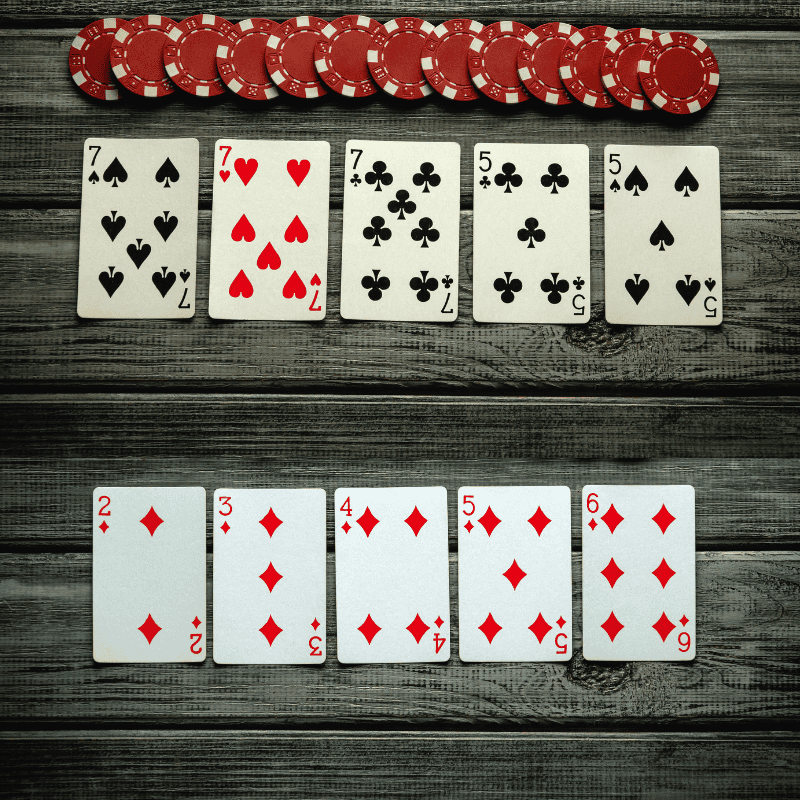
POKERMUSCLE FOR MULTI-CARD PLO
Find out about more our multi-card PLO analytics suite that runs lightning-fast
calculations for all PLO {4c, 5c, 6c} and PLO8 {4c, 5c, 6c} game variants.
Young as the game variant is, there is a lot of confusion about what strong strategy in a double board PLO game looks like, and I recently came across a post on this topic that made a number of errors. The very same reasoning errors that the coach made are likely prevalent amongst the current poker-playing population (try saying that quickly three times!), and so I have used them as a starting point for my own discussion of this intriguing PLO variant.
Please note that this article is not an ad hominem attack on the individual who wrote the post that I quote here, thus I have not linked out to that post so as to avoid sowing discord. I have no interest in excoriating anyone publicly, least of all a PLO coach from a prominent mainstream poker training site.
In fact, quite the contrary- this article is about the process of strategic reasoning in a novel, complex multi-card PLO variant. Double Board PLO is a tricky game to analyse correctly, and it’s easy to make significant strategic mistakes. If a player who produces training material for 4cPLO single board games can fail to reason accurately when confronted with a new game variant, then perhaps you can too.
Without further ado, I will present three lessons that you can take to your very next Bomb Pot.
Double Board PLO Bomb Pot Strategy
We will begin our analysis of DBPLO strategy by correcting a common misconception about the game, as delineated in this quote from the cited post.
“If you are almost guaranteed to win on one board but have nothing on the other board, you want people to fold because that is likely the only way you can win the full pot.”
Perhaps you yourself think that this statement is true. To convince you otherwise, let’s examine a couple of related results from the Pokermuscle Equity Analyzer together.
First, the three-handed scenario:
Hero’s hand, the A♠J♠5♥4♣, certainly qualifies as having nothing on Flop 1, and is the nuts on Flop 2.
Player 2 holds the second nuts on Flop 2, and a modest hand on Flop 1.
Player 3’s hand has almost nothing on Flop 2, and is the nuts on Flop 1.
My question is this:
Do you want to keep Player 2 in the pot, or kick him out?
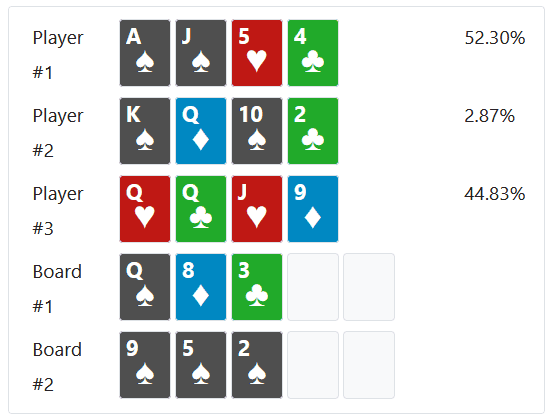
To expert poker players, the conclusion to draw from the first equity calculation is completely obvious. For those readers who do not classify themselves as expert, and for those who like to be thorough, I’ll share a little more detail. Our next equity calculation showcases the scenario where we hold exactly the same hand, and succeed in isolating ourselves to play heads-up against the Q♥Q♣J♥9♦:
It should be evident that our 52.3% share of a 3-handed pot is going to be worth a great deal more than 54.2% of a heads-up pot*, and that we would very much appreciate Player 2 continuing to make contributions to that 3-handed pot.
So our correspondent has made two errors in one sentence- because in our example, we don’t want people to fold, and it is a false assumption that we should predicate our entire Double Board PLO strategy on aiming to win the full pot.
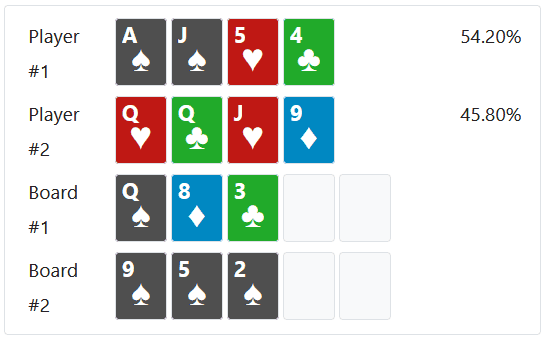
Lesson One:
One-way nut hands are pull hands on the flop.
*Aside for the pedants: Yes, if the SPR were sufficiently low then we would prefer the third player to fold rather than contribute a miniscule amount of money to the pot and retain a chance of winning. That scenario has been ignored for the purposes of this discussion.
Shared Cards in Double Board PLO Bomb Pots
The proceeding quote in the post from our correspondent gives an example to support his previous assertion. Whilst his example does not, in fact, support his assertion, it does provide us with the opportunity to perform a detailed analysis that will lead to an alternative and valuable conclusion.
“To demonstrate this, let’s use an example where the two flops are AKQ and 876. This hand is a good spot to use a large bet size because at this point in the hand, the two boards have nothing in common. If you have a hand like JT32 here, you benefit from trying to take the pot down so that you win the whole pot.”
The boards in the example are under-specified since there is no suit information- if both boards had two cards each of the same suit, they would certainly have a significant feature in common. However, we shall be charitable rather than churlish and pick two trichrome boards, which match only in their backdoor flush draws.
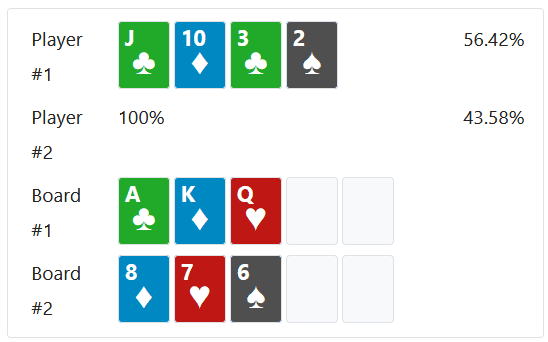
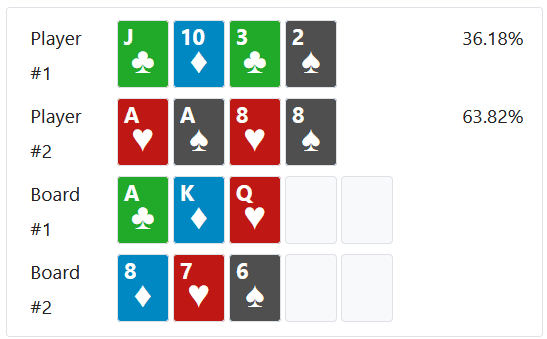
The first sign that the suggested line is not promising on this board is the fact that the aforementioned example hand (JT32) is only a 56-44 favourite against a single random hand on this particular board dyad, as shown by the calculation on the left-hand side. If we evaluate its equity heads-up against a promising hand, then the situation deteriorates dramatically. The A♥A♠8♥8♠ is a 64% favourite against the JT32, as shown in the right-hand side result above.
However, a detailed assessment of the equity structure is far more telling:
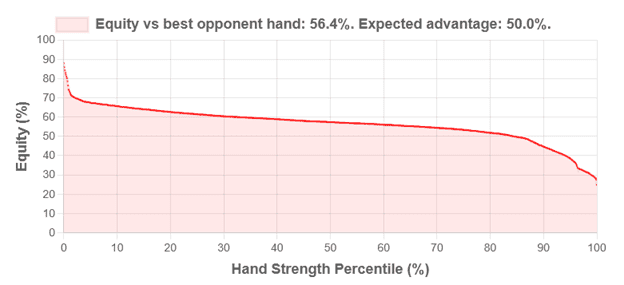
Heads-up against a random hand, the JT32 is behind 16% of the time, with an average equity of 41.1%. The problem is that, in the typical Double Board PLO bomb pot, one is facing not one but five random starting hands.
When I ran this simulation in the Pokermuscle Multiway Engine, I found that we could expect to be a 60-40 dog or worse against at least one opponent 33% of the time, averaging 33% equity when behind. At least one opponent will share the JT with us 27% of the time, and that opponent’s hand simply needs to contain a better holding than our nut gutter to have the advantage.
The root of the problem is in the class of example specified- a flopped nut straight. The fact that a flopped straight can be shared makes it especially unsuitable for driving the pot when one holds a one-board nut hand.
Lesson Two:
Made straights go down in value, due to the risk of shared cards being compounded by the split-pot structure.
Prime Cards in Double Board PLO
No introductory analysis of Double Board PLO would be complete without a survey of the general structure of the board dyads. Both flops are unpaired 68.6%, one flop is paired and the other unpaired 28.4% of the time, and both flops are paired 3% of the time.
What interests us here is the frequency with which particular card ranks on one board also appear on the other. I have tabulated that information below:
| Board Dyad Class | f(0 shared) | f(ABC-ABD) | f(ABC-ABC) | f(ABC-ADE) | f(AAB-ACD) | f(AAB-BCD) | f(AAB-ABC) |
|---|---|---|---|---|---|---|---|
| All | 60.8% | 29.0% | 4.9% | 0.1% | 3.3% | 4.9% | 0.5% |
| Unpaired-Unpaired | 50.3% | 42.4% | 7.1% | 0.2% | – | – | – |
| Paired-Unpaired | 69.4% | – | – | – | 11.5% | 17.3% | 1.7% |
| Paired-Paired | 83.9% | – | – | – | – | – | – |
From the table, we can deduce that at least one card rank will appear on both boards 39.2% of the time. We define the outstanding card(s) of those card ranks as Prime cards.
Whilst the ABC-ADE dyad is the most common prime dyad type that we encounter at the table, for this article our attention will rest on the two most salient prime dyad types, the AAB-ACD and ABC-ABD dyads. First, let us examine the AAB-ACD dyad:
The 7♣ is the prime card on this board dyad. With our example hand, we would have the clear advantage, with 76% equity against a random hand, and we are secure in the knowledge that no other player cant hold a 7.
Our only real fear with this hand is running into Aces, which will happen 10% in this 6-handed scenario. Against random Aces we are a 24% dog, and so our main concern holding the prime card on this board at a sufficiently low SPR is to extract value when we are ahead.
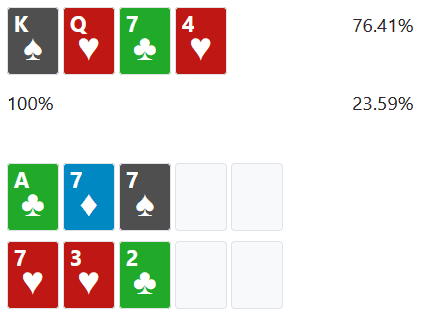
We now turn our attention to the ABC-ABD dyad:
The A♦ is the prime card on this board dyad and, as it is guaranteed to be the top rank, regardless of the board runout, it is an especially valuable prime card. Facing five opponents with top two pair in a single board 4cPLO game, we would be concerned about the threat of sets dominating our hand. Now, when top set is impossible, and with any other set only automatically dominating us on one board, the value of our prime two pairs is much higher.
Our example shows our hand as a 78% equity favourite heads-up against a random hand, but the more important result is from the Pokermuscle Multiway Engine, which has our hand as behind only 12% of the time in a 6-handed pot, with an average equity when behind of 43%. If we replace our Jack with a non-heart 7, then we will be behind 20% of the time, so it is essential to hold a premium hand or draw on both unpaired boards, even when we hold the prime card.
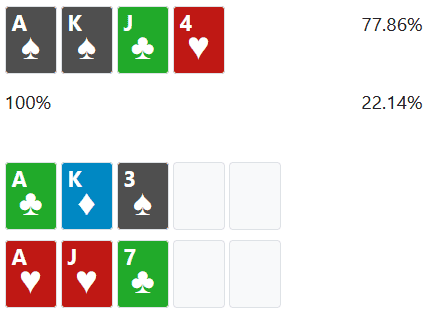
Lesson Three:
When both boards share a card rank, we should only bet for value with hands that are equal to or better than Prime card holdings.
POKERMUSCLE FOR MULTI-CARD PLO
Find out about more our multi-card PLO analytics suite that runs lightning-fast
calculations for all PLO {4c, 5c, 6c} and PLO8 {4c, 5c, 6c} game variants.
Of course, there is much more to be said about Prime cards, but the extensive additional research that is necessary to give an exhaustive account of this quintessential double board feature means that I save those insights for my private clients.
Phil’s Strategy Roundup
As a reminder, here are the three lessons demonstrated in this article:
- One-way nut hands are pull hands on the flop.
- Made straights go down in value, due to the risk of shared cards being compounded by the split-pot structure.
- When both boards share a card rank, we should only bet for value with hands that are equal to or better than Prime card holdings.
Bomb Pots are often three-or-more times the size of a regular pot and so accurate play will contribute disproportionately to your win-rate. With so many counter-intuitive situations to evaluate, especially in the 5cPLO and 6cPLO Bomb pots, my team has built a suite of Double Board Tools for all Omaha variants into my proprietary training web app, Pokermuscle.
If you are looking for an edge in any multi-card PLO variant, then I invite you to discover more about the Pokermuscle suite at this link.
Good luck at the tables.

 The ‘Poker Strategy Fundamentals’ series is a set of key articles written by myself, Phil Rocquemore, the founder and Research Director at Cardquant, to help you start thinking clearly and accurately about multi-card PLO game variants, like 5cPLO, 6cPLO, and Big O.
The ‘Poker Strategy Fundamentals’ series is a set of key articles written by myself, Phil Rocquemore, the founder and Research Director at Cardquant, to help you start thinking clearly and accurately about multi-card PLO game variants, like 5cPLO, 6cPLO, and Big O.